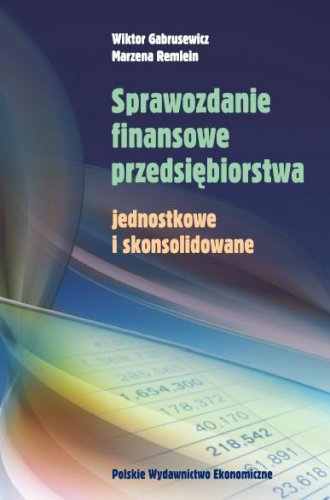Sprawozdanie finansowe przedsiębiorstwa jednostkowe i skonsolidowane
Publication date: 2011
Place publication: Warszawa
Publication: II zm.
Binding: paperback
Format: 162x237
The scope of the book contents covers both standalone and consolidated financial statements. The two types being quite different in their substance and principles of preparation, the book was divided into two parts accordingly. In part one the Authors presented the standalone financial statement with its general description and all components, i.e. balance sheet, profit and loss account, cash flow statement, statement of changes in equity, as well as additional information. In part two they presented the consolidated statement.
The principal objective of the book is to discuss individual components of both types of financial statements. The Authors described in an accessible manner individual categories inherent in the balance, in the profit and loss account as well as in the remaining components of financial statement. Methods of valuation of these categories are explained as is the manner of their presentation in the financial statement. Theoretical considerations are illustrated with examples – figures that make it easier to understand the contents of the financial statement of an enterprise and proper interpretations of its individual categories.
An assumed size of the book and its broad thematic scope only allowed the authors to present the most important issues without being able to deal in depth with all the problems. Instead, they refer readers to more detailed studies, some of them focused on only one component of financial statement and covering it exhaustively.
To be useful in this respect, the book includes a list of literature annexed at the end – publications the authors themselves took advantage of. Another strength of the publication is its comprehensive character: a single study that covers both standalone and consolidated financial statement of an enterprise. Of course, it is going to be useful for students of undergraduate, graduate and post-graduate studies. Additionally, it may be used in the educational process of accountants, financiers and corporate managers.
Spis treści
Wstęp
CZĘŚĆ I
SPRAWOZDANIE JEDNOSTKOWE PRZEDSIĘ BIORSTWA
Rozdział 1. Ogólna charakterystyka sprawozdawczości finansowej
1.1. Sprawozdawczość finansowa w systemie rachunkowości
1.2. Użytkownicy sprawozdań finansowych i ich potrzeby informacyjne
1.3. Cele sprawozdań finansowych
1.4. Podstawowe zasady sporządzania sprawozdań finansowych
1.5. Cechy jakościowe sprawozdania finansowego
1.6. Klasyfikacja sprawozdań finansowych
1.7. Sprawozdanie finansowe jednostki i jego elementy
1.8. Sporządzanie, zatwierdzanie i ogłaszanie sprawozdań finansowych
Rozdział 2. Bilans
2.1. Bilans jako podstawowy element sprawozdania finansowego
2.2. Ogólna charakterystyka aktywów i pasywów
2.3. Aktywa trwałe
2.3.1. Wartości niematerialne i prawne
2.3.2. Rzeczowe aktywa trwałe
2.3.2.1. Istota i klasyfikacja rzeczowych aktywów trwałych
2.3.2.2. Środki trwałe
2.3.2.3. Środki trwałe w budowie
2.3.3. Należności długoterminowe
2.3.4. Inwestycje długoterminowe
2.3.5. Długoterminowe rozliczenia międzyokresowe
2.4. Aktywa obrotowe
2.4.1. Zapasy
2.4.2. Należności krótkoterminowe
2.4.3. Inwestycje krótkoterminowe
2.4.4. Krótkoterminowe rozliczenia międzyokresowe
2.5. Kapitał (fundusz) własny
2.6. Zobowiązania i rezerwy na zobowiązania
Rozdział 3. Rachunek zysków i strat
3.1. Istota i zasady sporządzania rachunku zysków i strat
3.2. Formy rachunku zysków i strat
3.3. Przychody, koszty i wynik ze sprzedaży
3.3.1. Przychody, koszty i wynik ze sprzedaży w wariancie porównawczym rachunku zysków i strat
3.3.2. Przychody, koszty i wynik ze sprzedaży w wariancie kalkulacyjnym rachunku zysków i strat
3.4. Pozostałe przychody i koszty operacyjne oraz wynik z działalności operacyjnej
3.5. Przychody i koszty finansowe oraz wynik z działalności gospodarczej
3.6. Wynik zdarzeń nadzwyczajnych oraz wynik brutto
3.7. Podatek dochodowy i pozostałe obowiązkowe zmniejszenia zysku (zwiększenia straty) oraz wynik netto
Rozdział 4. Rachunek przepływów pieniężnych
4.1. Istota i cel rachunku przepływów pieniężnych
4.2. Metody sporządzania rachunku przepływów pieniężnych
4.2.1. Metoda bezpośrednia
4.2.2. Metoda pośrednia
4.3. Rodzaje działalności w rachunku przepływów pieniężnych
4.3.1. Przepływy pieniężne z działalności operacyjnej
4.3.2. Przepływy pieniężne z działalności inwestycyjnej
4.3.3. Przepływy pieniężne z działalności finansowej
4.4. Wartość poznawcza rachunku przepływów pieniężnych
4.5. Przykład sporządzania rachunku przepływów pieniężnych
Rozdział 5. Zestawienie zmian w kapitale (funduszu) własnym
5.1. Istota i struktura zestawienia zmian w kapitale (funduszu) własnym
5.2. Zasady sporządzania zestawienia zmian w kapitale (funduszu) własnym
5.3. Przykład sporządzania zestawienia zmian w kapitale (funduszu) własnym
Rozdział 6. Informacja dodatkowa
6.1. Istota, funkcje i struktura informacji dodatkowej
6.2. Wprowadzenie do sprawozdania finansowego
6.3. Dodatkowe informacje i objaśnienia
CZĘŚĆ II
SPRAWOZDAWCZOŚĆ FINANSOWA GRUP KAPITAŁOWYCH
Rozdział 7. Ogólne zasady konsolidacji sprawozdań finansowych
7.1. Istota i podstawy prawne funkcjonowania grup kapitałowych
7.2. Istota i cel konsolidacji sprawozdań finansowych
7.3. Zakres podmiotowy konsolidacji sprawozdań finansowych
7.4. Organizacja rachunkowości jednostek grupy kapitałowej dla celów konsolidacji sprawozdań finansowych
7.5. Metody konsolidacji i wyceny udziałów w jednostkach podporządkowanych
Rozdział 8. Konsolidacja metodą pełną
8.1. Istota metody konsolidacji pełnej
8.2. Konsolidacja sprawozdań finansowych na dzień rozpoczęcia sprawowania kontroli
8.2.1 Wycena aktywów netto jednostki zależnej
8.2.2. Sumowanie jednostkowych sprawozdań finansowych
8.2.3. Korekty kapitałowe
8.3. Konsolidacja sprawozdań finansowych na koniec roku obrotowego
8.3.1. Korekty kapitałowe
8.3.2. Wyłączenia transakcyjne
8.3.3. Odpisy wartości firmy
8.3.4. Wycena kapitałów mniejszości
8.4. Konsolidacja w następnych okresach sprawozdawczych
Rozdział 9. Metoda proporcjonalna
9.1. Istota metody proporcjonalnej
9.2. Metoda konsolidacji proporcjonalnej na dzień rozpoczęcia sprawowania współkontroli
9.3. Zastosowanie metody proporcjonalnej na koniec okresu sprawozdawczego
Rozdział 10. Metoda praw własności
10.1. Istota metody praw własności
10.2. Wycena udziałów metodą praw własności
Literatura
| Odbiór osobisty | 0 € |
| Kurier Inpost | 4 € |
| Kurier FedEX | 4 € |
| Inpost Paczkomaty | 4 € |
| Free delivery in Reader's Club | from 47 € |



